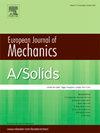用离散元法(DEM)模拟无冲击剥落破碎
IF 4.2
2区 工程技术
Q1 MECHANICS
引用次数: 0
摘要
在本研究中,采用离散元法(DEM)来模拟高应变率无冲击载荷下氧化铝陶瓷的动态行为和破碎机制。模拟了高脉冲功率(GEPI)剥落实验。DEM允许在微观键参数校准时考虑样品内应力波的准确传播和相互作用。结果表明,标准破坏准则可以有效地反映剥落现象,但在应变速率较高时,与实验数据的差异会增大。为了解决这个问题,该研究将DEM方法与损伤律(特别是一阶和二阶Kachanov损伤律)相结合,以模拟裂纹的起裂和扩展。与实验后表面速度曲线的对比分析验证了该方法的有效性。利用强度递增的加载脉冲诱发不同的应变率水平,探讨了当前DEM模型的应变率敏感性。该研究表明,DEM方法可以有效地模拟脆性固体的动态行为,导致对应变速率敏感的多重破碎。本文章由计算机程序翻译,如有差异,请以英文原文为准。
Simulation of shockless spalling fragmentation using the Discrete Element Method (DEM)
In the present study a Discrete Element Method (DEM) is considered to model the dynamic behaviour and fragmentation mechanisms of alumina ceramic under high strain-rate shockless loading. GEPI (high-pulsed power) spalling experiments are simulated. The DEM allows to take into account the accurate propagation and interaction of stress waves within the samples upon calibration of microscopic bond parameters. The results indicate that a standard failure criterion can effectively represent the spalling phenomenon, though discrepancies with experimental data increase at higher strain rates. To address this, the study combines the DEM approach with a damage law, specifically the first and second order Kachanov damage law, to model crack initiation and propagation. Comparative analysis with experimental rear face velocity profiles validates the approach. The strain-rate sensitivity of the present DEM model is explored using loading pulses of increasing intensity that induce different strain-rate levels. This research demonstrates that the DEM approach can effectively model dynamic behaviour in brittle solids leading to a multiple fragmentation sensitive to the strain rate.
求助全文
通过发布文献求助,成功后即可免费获取论文全文。
去求助
来源期刊
CiteScore
7.00
自引率
7.30%
发文量
275
审稿时长
48 days
期刊介绍:
The European Journal of Mechanics endash; A/Solids continues to publish articles in English in all areas of Solid Mechanics from the physical and mathematical basis to materials engineering, technological applications and methods of modern computational mechanics, both pure and applied research.

 求助内容:
求助内容: 应助结果提醒方式:
应助结果提醒方式:


